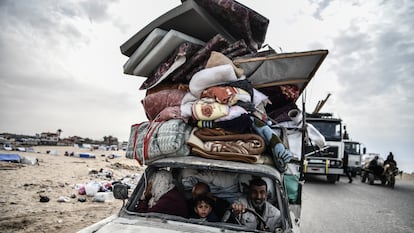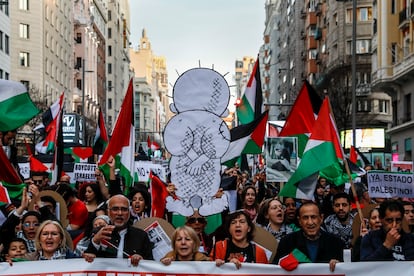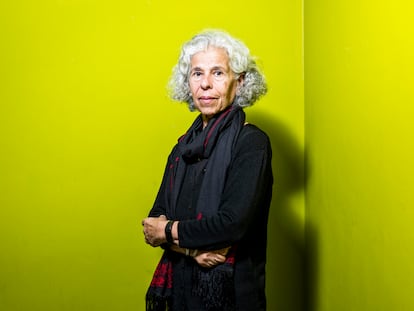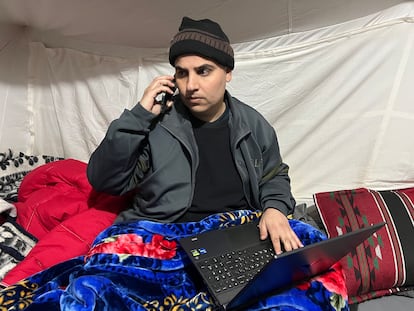Palestinian refugees’ right of return: Israel’s eternal battle against the UNRWA
Several experts believe that Israel has linked the agency to the Hamas attacks in a bid to put an end to this principle, which was recognized by the U.N. in 1948

“We must do everything to ensure they never do return.” Israeli prime minister David Ben Gurion wrote this down in his diary on July 18, 1948, two months after proclaiming the creation of Israel. The “they” he was referring to were the 700,000 Palestinians — more than half of the local population — who had been expelled or forced into exodus by the massacres committed by Zionist militias.
That collective wound — known by Palestinians as the Nakba (meaning “catastrophe”) — is inseparable from the history of Israel. It’s also inseparable from the creation of the United Nations Relief and Works Agency for Palestine Refugees in the Near East (UNRWA), the humanitarian aid agency for Palestinian refugees, which over time has become the repository of the memory of their exile. The agency’s records, photographic archives, certificates accrediting the refugees as such, are the passport that should guarantee them the right to return to what is now Israeli territory and recover their property or to be compensated for their loss. The United Nations recognized the Palestinian right of return in 1948, but Israel has failed to accept it.
Few of the 700,000 refugees registered by the U.N. still remain, but among those still living and their descendants, there are 5.9 million people registered by UNRWA in Gaza, the West Bank, Syria, Lebanon and Jordan. Their return to Israel would leave the Jews in the minority and compromise the country’s character as a “nation-state of the Jewish people,” says Julieta Espín Ocampo, an expert in the UNRWA, who argues that the right of return “threatens the very existence of the Israeli state.” Espín Ocampo believes that Israel accused UNRWA employees of taking part in the Hamas attack on October 7 partly due to the agency’s connection with the right of return.
Israel has not offered concrete evidence that a dozen of UNRWA’s 31,000 workers were allegedly involvement in the attack against Israel, which killed 1,200 people. Despite this, 16 countries — including its two main donors, the United States and Germany — suspended funding to the U.N. agency, jeopardizing the humanitarian aid it provides, particularly in Gaza, where 85% of the population has been displaced by Israeli attacks and is on the brink of starvation. Israel’s offensive in Gaza has killed more than 28,000 people, according to data from the Hamas-controlled Gazan Health Ministry, which the U.N. believes is credible.
As a result of the war, Gazans depend on UNRWA for aid now more than ever. They also depend on the agency for shelter. According to UNRWA data, 1.7 million displaced Gazans — out of a total population of 2.3 million — have sought shelter in UNRWA facilities since the start of the war. And 154 UNRWA workers have been killed in the war.
Lubnah Shomali, an advocacy officer in Ramallah (West Bank) of the BADIL Resource Center for Palestinian Residency and Refugee Rights, agrees that Israel’s years-long attacks on the UNRWA serve several objectives brought to the fore by the war in Gaza. According to the expert from BADIL, which holds U.N. consultative status, Israel’s first goal is ending UNRWA humanitarian aid “to expel the Palestinians from the enclave” and annex it to Israel. “[Israel] is creating what in international law is known as a coercive environment: with no food, water, medical care, electricity and shelter, you either stay and die, or you leave.” Another of Israel’s goals is to “eliminate the right of return” of 5.9 million Palestinian refugees, says Shomali.
“The very existence of the agency, that its mandate is to provide such assistance to Palestinian refugees, is a threat to Israel’s narrative and its insistence that Palestinian refugees do not exist. And if there are no refugees, there is no right of return,” she explains.
In a message posted on X on February 1, Israeli government spokesperson Eylon Levy equated the right of return with “an unlimited right of Palestinian immigration (for 5.9 million people).” Under Israeli laws, Jews of any nationality have the right to immigrate to Israel — a right that Palestinian refugees do not enjoy.
Three days after Levy’s message, Israeli Foreign Minister Israel Katz posted: “UNRWA, entangled with Hamas’s terrorist activities in Gaza, perpetuates the false narrative of Palestinian ‘refugees’ needing to return to Israel. We are actively working to disengage UNRWA from Gaza. They are a part of the problem and not a part of the solution.”
Last Wednesday, in an address to the nation, Israeli Prime Minister Benjamin Netanyahu also accused the agency of “perpetuating the Palestinian refugee problem.”
UNRWA, entangled with Hamas's terrorist activities in Gaza, perpetuates the false narrative of Palestinian 'refugees' needing to return to Israel. We are actively working to disengage @UNRWA from Gaza. They are a part of the problem and not a part of the solution.
— ישראל כ”ץ Israel Katz (@Israel_katz) February 4, 2024
The U.N. agency’s mandate does not include encouraging the return of Palestinian refugees to their homeland, but the text of Resolution 302 of 1949, which created it, does mention another resolution, Resolution 194, which establishes the right of return. The agency provides emergency humanitarian assistance to more than 1.5 million Palestinian refugees in Gaza. Of the nearly half a million refugee children attending its more than 700 schools, almost 300,000 were studying in the Gaza Strip before the war. These huge numbers are explained by the Nakba: 1.5 million Gazans, out of the enclave’s 2.3 million inhabitants, are refugees. UNRWA assists and provides education, health, microcredit and other aid to Gazans, as well as to the 4.4 million refugees in the West Bank, Jordan, Syria and Lebanon, according to agency data.
“UNRWA, a U.N. agency dedicated to Palestinian refugees, is a reminder of why they are still refugees and why they are not allowed to return,” says historian Jorge Ramos Tolosa, author of several books on Palestine and Israel and professor at the University of Valencia in Spain.
Tolosa says the agency shows that “Israel is a colonial and exclusivist project that gives all rights to Jewish people, yet takes away the right of Palestinians to live on their land.” “The very term refugee reminds Israel of how its state was created in 1948: the Nakba. That is its Pandora’s box,” he adds.
Isaías Barreñada, a professor at the Complutense University of Madrid, who is also an expert on the Middle East, argues that Israel “is trying to strangle UNRWA so that it cannot fulfill its mandate and is doomed to disappear, thinking in a somewhat simplistic way that this will also make the refugee question disappear.”
Forgetting Palestinian refugees
“The old will die; the young will forget.” That’s what Ben Gurion is believed to have said about the Nakba. The Israeli prime minister was not counting on the strong sense of Palestinian identity, refugees’ determination to return, nor on the fact that the U.N. refugee agency would “involuntarily” contribute to the memory and construction of Palestinian nationalism, says Espín Ocampo, who wrote his PhD thesis on the UNRWA.
“Identity cards, ration cards, health services, but, above all, the refugee camps [58, in which 1.5 million refugees still live] and the educational system offered by UNRWA had a profound influence on the evolution of Palestinian identity and the ensuing Palestinian struggle,” he explains in an article.
Humanitarian aid and jobs in the agency — 95% of its 31,000 employees are refugees — have brought Palestinians together in Gaza, the West Bank and neighboring states. Contrary to Israel’s wishes, they have not lost their identity and assimilated to their host countries.

On the Israeli wall that surrounds the West Bank, on T-shirts, wall hangings and banners at Gaza demonstrations around the world, one image is especially popular: Handala, a cartoon of a 10-year-old refugee boy created by Naji al-Ali. Like Handala, al-Ali was 10 years old when he was forced to leave Palestine. The cartoonist says Handala will only grow up when he returns to his homeland.
According to an essay by artist Fayeq Oweis, the image of Handala — a ragged, barefoot boy — embodies “the bitterness, resilience and dignity” of Palestine. It has become a symbol against injustice and a national icon for Palestinians. Naji al-Ali was assassinated in London in 1987. The attack was believed to have been carried out by an Israeli Mossad double agent.
Sign up for our weekly newsletter to get more English-language news coverage from EL PAÍS USA Edition









































